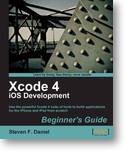XCode 4 iOS Development by Steven F. Daniel
Summary: for beginners
At the time of writing this review, there were only, like, five books related to the topic. And the topic is hot! If you want to start iOS 5 development, you will face XCode 4 sooner then you expect. Why? Answer is simple. XCode is the only way you can develop for iOS.
When it comes to iOS based development you will need to learn two different aspects of it. Objective-C and the IDE (XCode 4). Being honest, if you have no idea regarding Objective-C do not make an assumption that this book will teach you it. No chance. It covers just a basics of the language. Even more, it explains some ideas via Java examples – which is even more confusing. After all, not everybody knows Java. So, let me tell you something. If you want to learn the language get something serious, like “Programming in Objective-C 2.0” by S. Kochan.
Other side of the coin is the XCode 4. This is the tool that combines every aspect of the development process – language, device, simulator, SVN, diff tool and many, many more. This is the place where the book takes over. Steven will guide you through various aspects of the development in tutorial like meaner. Each chapter focuses on different aspects and all of them are explained in a “show and tell” way. Basically, you have to follow Steven as you go. As a person who already knows XCode 4 I was caught up by the suggestions provided by Steven in few places. Even though there are things left behind there is still lots of knowledge in here. This is Beginner Guide after all. You simply can not tell everything in a reasonably amount of pages. However, you get everything that is required to get started. You even get the description of Instruments, Debugger, DTrace, and Analyze tools. This is really helpful.
There are few missing points though. Steven focuses on XCode 4 and iOS 4. At the time of writing there were already XCode 4.2 and iOS 5 on the market. This make some impact on the book. You will not get Storyboards description as well as ARC – these two can make your development process much easier.
There are few places where small issues appear. For example, XCode related applications are installed into /Developer directory instead of /XCode4, and it would be nice to mention that main purpose of application testing on the device is the different architecture of the code. Simulator uses i386 while device is based on armv.
In overall, I think this book is worth considering. But, once again, it will not teach you Objective-C. Buy it only and only as an introduction to XCode 4. In that case you should be happy with it.
Product page:
Packt: http://www.packtpub.com/xcode-4-ios-iphone-development-beginners-guide/book
Amazon (in Books): Xcode 4 iOS Development Beginner’s Guide
Amazon (Kindle): Xcode 4 iOS Development Beginner’s Guide
